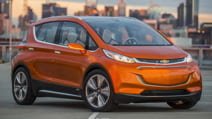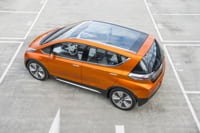MitchJi
10 MW
Hi,
What will the Volt do to already slow Volt sales, and to Volt resale value?
http://thinkprogress.org/climate/2015/01/12/3610461/gm-chevy-aim-at-tesla-with-new-bolt/
What will the Volt do to already slow Volt sales, and to Volt resale value?
http://thinkprogress.org/climate/2015/01/12/3610461/gm-chevy-aim-at-tesla-with-new-bolt/
Watch out Tesla, General Motors has you in its crosshairs. On Monday, Chevrolet, a division of GM, revealed plans to launch the $30,000 Bolt, a car that the company intends to directly compete with Tesla’s forthcoming third vehicle, the Model III, which will have a similar price tag and a similar range of slightly over 200 miles-per-charge.
GM is showing a concept version of the Bolt this week at the Detroit auto show, where the company is also announcing an updated Volt, the company’s flagship hybrid vehicle. The redesigned Volt will be able to travel up to 50 miles on electric power alone, an increase of 12 miles over the previous model, and over 1,000 miles on average without filling up on gas.
GM and Chevy have been pursuing electric vehicles for several decades and the Bolt is an indication that the company is prepared to double-down on this wager even as Volt sales struggle and gas prices plunge. As the Wall Street Journal notes, the Bolt is the biggest risk yet taken by GM’s new Chief Executive Mary Barra, who took over around a year ago. She originally approved its design during her former post as product chief.
“The Bolt EV concept demonstrates General Motors’ commitment to electrification and the capabilities of our advanced EV technology,” said Barra in a statement. “Chevrolet believes electrification is a pillar of future transportation and needs to be affordable for a wider segment of customers.”
Barra also said that the Bolt is designed for “attainability, not exclusivity.” It is clear that GM wants the Bolt to be appealing beyond what’s under the hood. As Ed Welburn, vice president of GM Global Design, said: “form and function have never meshed so well together.”
The Bolt will have a 10-inch dashboard touchscreen, the option of using a smartphone as a key, integrated ride-sharing management, and the ability to self-park: using a phone App, the Bolt will be able to park itself once the driver is out of the car and then return to the driver’s location later all by itself.
2015 Chevrolet Bolt EV Interior
CREDIT: COURTESY OF GENERAL MOTORS
Even with the extended 200-mile range — intended to reassure drivers that they won’t end up stranded — sleek hatchback look, and impressive gadgetry, GM has its work cut out for it competing with Tesla. Owned by billionaire inventor Elon Musk, Tesla is a consumer favorite, known for making big headlines and even bigger pronouncements. Late last year the company secured a spot in Nevada to build its $5 billion lithium-ion battery gigafactory. In the last year, GM’s shares have fallen 14 percent while Tesla’s have climbed 48 percent.
Tesla is not the only competitor. While less than 90,000 Chevy Volts have sold since the vehicle went on sale in 2010 — and only 1,500 were delivered in December — Nissan’s fully electric car, the Leaf, just broke an electric plug-in sales record with 30,200 sold in the U.S. in 2014. The Leaf gets about 84 miles on a charge.
With the global car market in the tens of millions per year, the success of one electric vehicle far from negates the chances of another. As EV infrastructure and charging stations become more common, prices drop, and technology continues to improve, these automakers hope the market will finally really open up to them.
“We’re in this for the long haul,” Barra recently said while discussing the impact of cheaper gas prices on electric vehicles. “Over the long-term it doesn’t change our strategy at all.”



